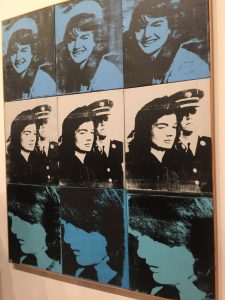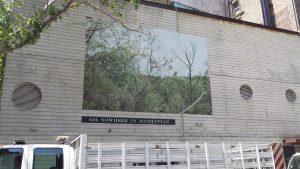 There were two major themes to our fourth day in The Big Apple: awe at the amount of activities we can squeeze into a day in Manhattan, and the exhaustion of a jet set life– after all we are in the city that never sleeps. After exploring the local night life and catching up with family on a late night phone call on Monday (and catching the final minutes of the Pens v. Sharks Game 1 of the Stanley Cup Finals), I among most of our crew was dragging a bit Tuesday morning with our earlier start.
There were two major themes to our fourth day in The Big Apple: awe at the amount of activities we can squeeze into a day in Manhattan, and the exhaustion of a jet set life– after all we are in the city that never sleeps. After exploring the local night life and catching up with family on a late night phone call on Monday (and catching the final minutes of the Pens v. Sharks Game 1 of the Stanley Cup Finals), I among most of our crew was dragging a bit Tuesday morning with our earlier start.
We perked up in our meeting with Terri Wilder at the Spencer Cox Center for Health where we discu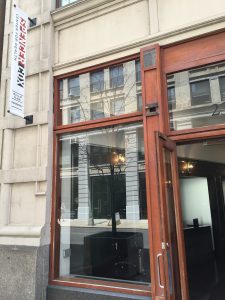 ssed HIV transmission and epidemiology, services offered at the Mt Sinai Clinics around Manhattan, and policies in NY State surrounding HIV. We also were fortunate enough to get to speak with a woman from the Peer Program at the clinic that supports those with new positive diagnosis as they learn to live with and manage their new health condition. The program is a compassionate and human centered approach to treatment, coping, and management. It was phenomenal to get to speak with an Undetectable viral load HIV + person who helped others with the same condition to continue their lives normally.
ssed HIV transmission and epidemiology, services offered at the Mt Sinai Clinics around Manhattan, and policies in NY State surrounding HIV. We also were fortunate enough to get to speak with a woman from the Peer Program at the clinic that supports those with new positive diagnosis as they learn to live with and manage their new health condition. The program is a compassionate and human centered approach to treatment, coping, and management. It was phenomenal to get to speak with an Undetectable viral load HIV + person who helped others with the same condition to continue their lives normally.
The old folks of our group headed toward 7th Ave for lunch on suggestion of Terri and ended up at Cafeteria in Chelsea. Which was, of course, DELICIOUS and the service was on point.
We were also fortunate enough to get to spend the entire day with Michael from ACT UP NY who taught us some thrifty NY Living Hacks and bought street vendor fans with us on Canal Street to cool off in the humid heat. From awe at the vastness of service provided at Spencer Cox during our tour of the facility, to trekking across town talking to the students about the best places in NYC as we passed them, to scoring us a subway map (which doubles as wrapping paper), Michael was a constant bright spot in the day for the students. We rotated turns walking with him and discussing life in the city, as well as attempted to formulate a plan to bring him along to Berlin and Paris.
We ventured into the subway for the second time as a group for a trip downtown to see the Leslie-Lohman Museum, the na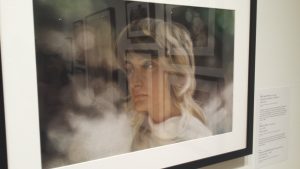 tions only accredited predominantly queer art museum. With a fabulous exhibit tour to rival that of Dr. Katz, we shuffled off to another event in our busy schedule.
tions only accredited predominantly queer art museum. With a fabulous exhibit tour to rival that of Dr. Katz, we shuffled off to another event in our busy schedule.
Making it back up town a bit to the LGBTQ Center, we met with
Executive Director Glennda Testone for a tour of the beautiful facility.

All of our guests for the day made it abundantly clear how much we were packing into our time in the city. One of them even remarked how, living in New York, they still had so much to see and do, yet we were all making the most of our time and availability.
Being cut loose from the Center, those of us heading to the Theatre D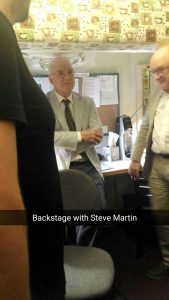 istrict gathered for a subway ride to Midtown. We grabbed some tasty standard grub at Applebee’s and split off to our respective shows. Five of us went to Wicked, and I slid over to Bright Star for an amazing job shadow opportunity with their stage management team. Meeting Michael Passaro, watching the show call from back stage, getting a lot of industry questions answered, and getting to see Steve Martin perform the En’tract for Act Two are the quick and dirty highlights.
istrict gathered for a subway ride to Midtown. We grabbed some tasty standard grub at Applebee’s and split off to our respective shows. Five of us went to Wicked, and I slid over to Bright Star for an amazing job shadow opportunity with their stage management team. Meeting Michael Passaro, watching the show call from back stage, getting a lot of industry questions answered, and getting to see Steve Martin perform the En’tract for Act Two are the quick and dirty highlights.
After my fourth long day in a row, I’m ready to settle in a little earlier than I have been and write my journal to the soundtrack of showtunes. While those around Union Square are just kicking into life, I’ll be becoming an unconscious blob.

 specifically on sexuality, she said that in ancient societies such as Greece and Rome, same sex relationships were completely normal, only they were called pederasty. It was not until the Catholic Reformation beginning in the 16th century that it was made out to be a near unforgivable sin, punishable by death. Laws started to be made criminalizing same sex acts. Nonetheless, queer people started to form a culture despite all of the oppression that they faced, and developing a collective identity. In the 19th century, there was more research that went into understanding people with same sex desires. However, the term “homosexual” was first coined in 1868 as medical terminology to describe a mental illness; an illness which people began trying to “cure.” Though we have made great strides since then, we still see people today who believe in curing homosexuality through conversion therapy. Nina wrapped up this history by saying it is only in the last 100 years that homosexuality has come to be viewed as a lifestyle. Though this has been a good way for gay and lesbian people to begin to develop a life suited around their identities, I believe referring to homosexuality as a lifestyle rather than an identity has also fed to the idea that it is a choice, which is certainly not the case.
specifically on sexuality, she said that in ancient societies such as Greece and Rome, same sex relationships were completely normal, only they were called pederasty. It was not until the Catholic Reformation beginning in the 16th century that it was made out to be a near unforgivable sin, punishable by death. Laws started to be made criminalizing same sex acts. Nonetheless, queer people started to form a culture despite all of the oppression that they faced, and developing a collective identity. In the 19th century, there was more research that went into understanding people with same sex desires. However, the term “homosexual” was first coined in 1868 as medical terminology to describe a mental illness; an illness which people began trying to “cure.” Though we have made great strides since then, we still see people today who believe in curing homosexuality through conversion therapy. Nina wrapped up this history by saying it is only in the last 100 years that homosexuality has come to be viewed as a lifestyle. Though this has been a good way for gay and lesbian people to begin to develop a life suited around their identities, I believe referring to homosexuality as a lifestyle rather than an identity has also fed to the idea that it is a choice, which is certainly not the case. 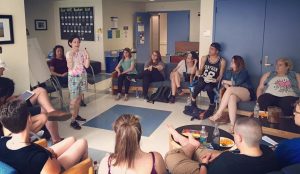 through her process of how she goes from a basic idea to a full fledged “direct action.” It all starts with a vision: an all encompassing mission that should shine through in every action you plan to do to promote your cause. You also need to have goals: measurable and concrete things you’re trying to achieve.
through her process of how she goes from a basic idea to a full fledged “direct action.” It all starts with a vision: an all encompassing mission that should shine through in every action you plan to do to promote your cause. You also need to have goals: measurable and concrete things you’re trying to achieve. 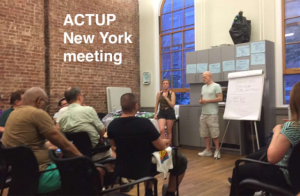 leased in 1996, which saved the lives of approximately 6 million already infected people that would have otherwise been doomed by the virus. We were able to meet individuals who were long time survivors of HIV and activists who had been fighting for the cause for many years, some of them since the movement first came together in the late 1980’s. It was extraordinary to be in the presence
leased in 1996, which saved the lives of approximately 6 million already infected people that would have otherwise been doomed by the virus. We were able to meet individuals who were long time survivors of HIV and activists who had been fighting for the cause for many years, some of them since the movement first came together in the late 1980’s. It was extraordinary to be in the presence of such heroic people whose activism has saved so many lives over the years. What was perhaps most incredible though, was that the ACT UP members were just normal people. It reminded me that anyone really can make a difference.
of such heroic people whose activism has saved so many lives over the years. What was perhaps most incredible though, was that the ACT UP members were just normal people. It reminded me that anyone really can make a difference.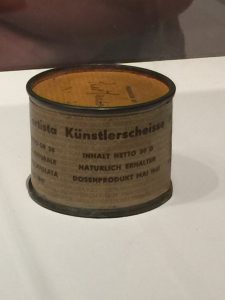 something private that we are taught not to speak of. And it is a symbolic representation of the notion that society seeks to com-modify everything, including one famous artist’s excrement.
something private that we are taught not to speak of. And it is a symbolic representation of the notion that society seeks to com-modify everything, including one famous artist’s excrement.